1999 FORD E-450 brake light
[x] Cancel search: brake lightPage 131 of 208
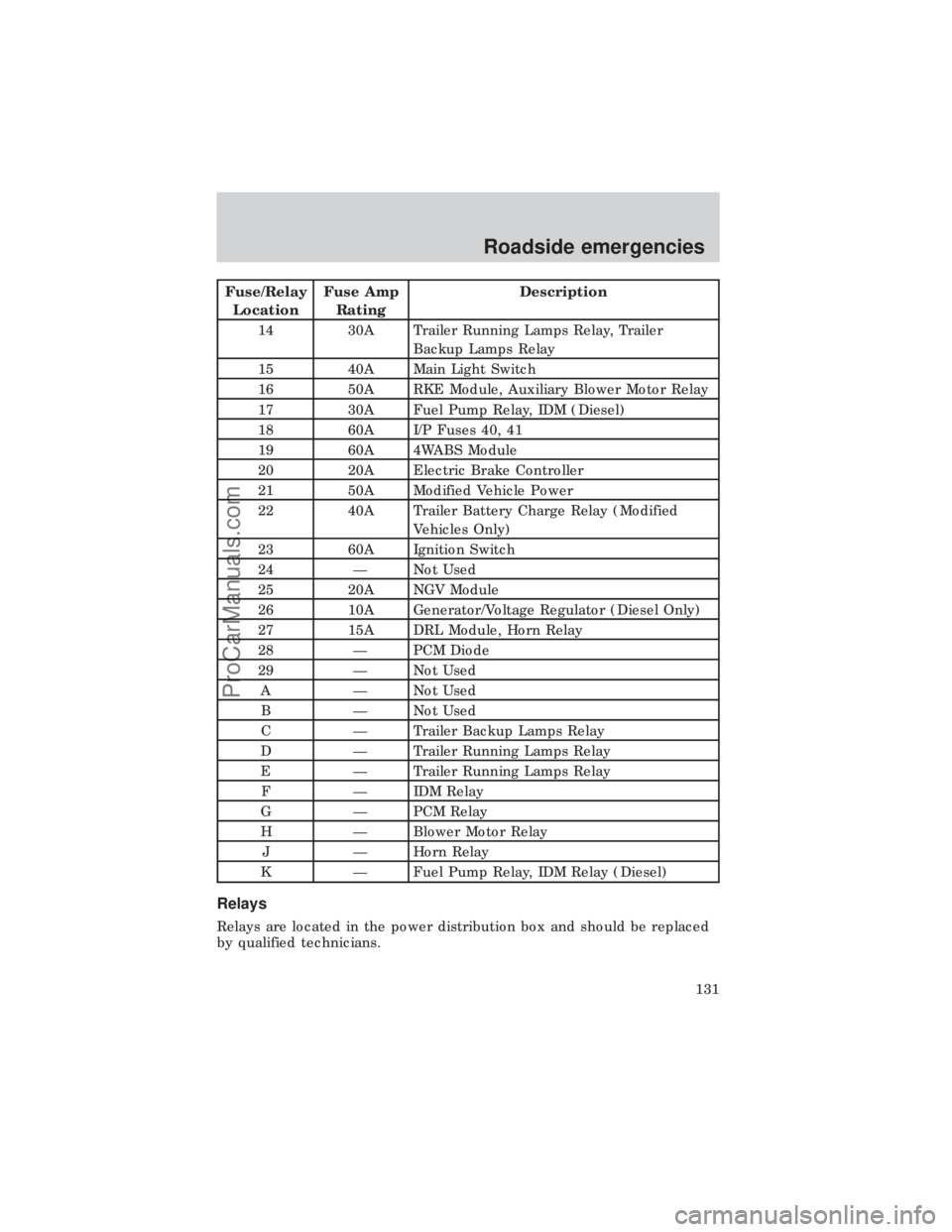
Fuse/Relay
LocationFuse Amp
RatingDescription
14 30A Trailer Running Lamps Relay, Trailer
Backup Lamps Relay
15 40A Main Light Switch
16 50A RKE Module, Auxiliary Blower Motor Relay
17 30A Fuel Pump Relay, IDM (Diesel)
18 60A I/P Fuses 40, 41
19 60A 4WABS Module
20 20A Electric Brake Controller
21 50A Modified Vehicle Power
22 40A Trailer Battery Charge Relay (Modified
Vehicles Only)
23 60A Ignition Switch
24 Ð Not Used
25 20A NGV Module
26 10A Generator/Voltage Regulator (Diesel Only)
27 15A DRL Module, Horn Relay
28 Ð PCM Diode
29 Ð Not Used
A Ð Not Used
B Ð Not Used
C Ð Trailer Backup Lamps Relay
D Ð Trailer Running Lamps Relay
E Ð Trailer Running Lamps Relay
F Ð IDM Relay
G Ð PCM Relay
H Ð Blower Motor Relay
J Ð Horn Relay
K Ð Fuel Pump Relay, IDM Relay (Diesel)
Relays
Relays are located in the power distribution box and should be replaced
by qualified technicians.
Roadside emergencies
131
ProCarManuals.com
Page 145 of 208

SERVICE RECOMMENDATIONS
To help you service your vehicle:
²We highlight do-it-yourself items in the engine compartment for easy
location.
²We provide a ªService Guideº which makes tracking routine service
easy.
If your vehicle requires professional service, your dealership can provide
necessary parts and service. Check your ªWarranty Guideº to find out
which parts and services are covered.
Use only recommended fuels, lubricants, fluids and service parts
conforming to specifications. Motorcraft parts are designed and built to
provide the best performance in your vehicle.
PRECAUTIONS WHEN SERVICING YOUR VEHICLE
Be especially careful when inspecting or servicing your vehicle.
²Do not work on a hot engine.
²When the engine is running, make sure that loose clothing, jewelry or
long hair does not get caught up in moving parts.
²Do not work on a vehicle with the engine running in an enclosed
space, unless you are sure you have enough ventilation.
²Keep all lit cigarettes, open flames and other lit material away from
the battery and all fuel related parts.
If you disconnect the battery, the engine must ªrelearnº its idle
conditions before your vehicle will drive properly, as explained inBattery
in this chapter.
Working with the engine off
1. Set the parking brake and ensure the gearshift is securely latched in P
(Park).
2. Turn off the engine and remove the key.
3. Block the wheels to prevent the vehicle from moving unexpectedly.
Working with the engine on
1. Set the parking brake and ensure the gearshift is securely latched in P
(Park).
2. Block the wheels to prevent the vehicle from moving unexpectedly.
Maintenance and care
145
ProCarManuals.com
Page 160 of 208
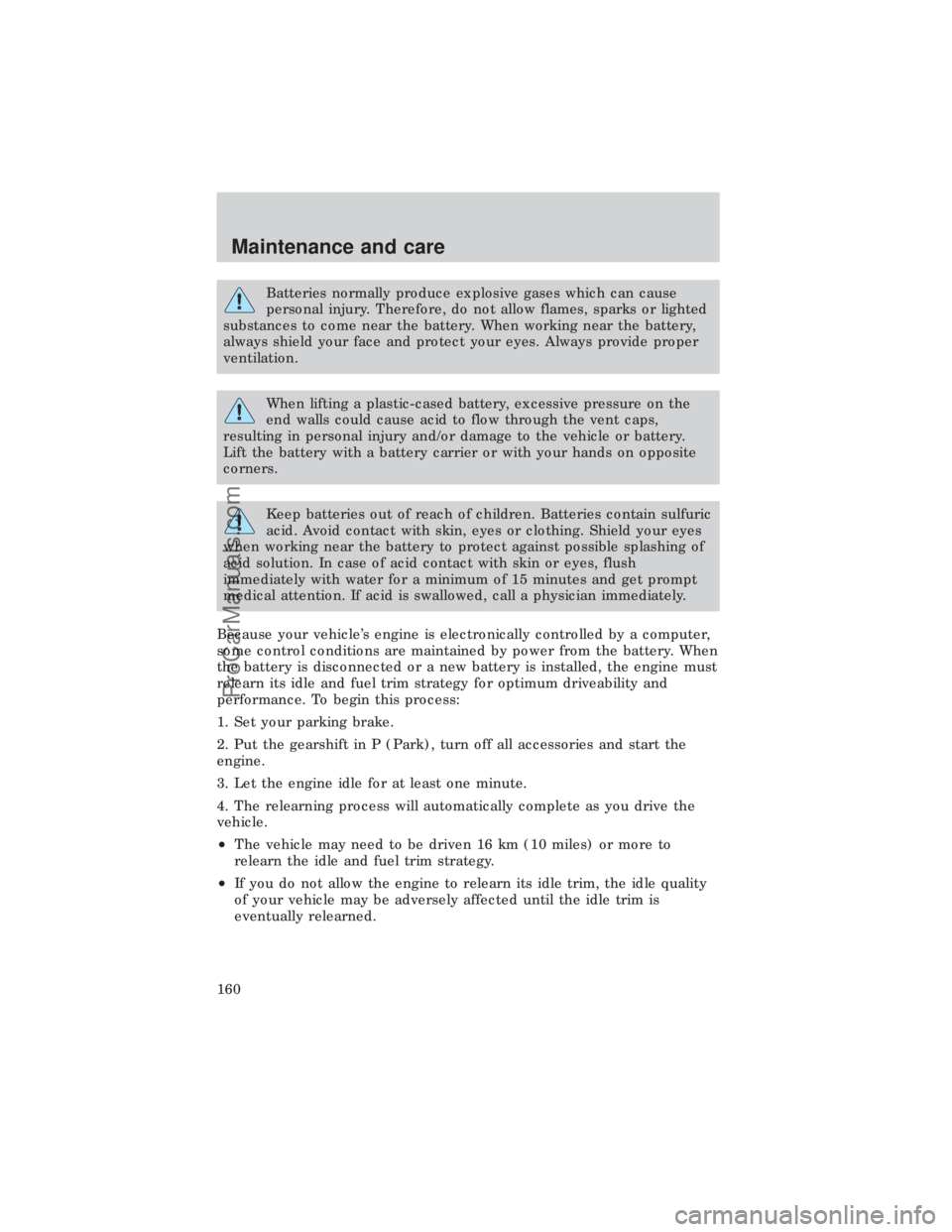
Batteries normally produce explosive gases which can cause
personal injury. Therefore, do not allow flames, sparks or lighted
substances to come near the battery. When working near the battery,
always shield your face and protect your eyes. Always provide proper
ventilation.
When lifting a plastic-cased battery, excessive pressure on the
end walls could cause acid to flow through the vent caps,
resulting in personal injury and/or damage to the vehicle or battery.
Lift the battery with a battery carrier or with your hands on opposite
corners.
Keep batteries out of reach of children. Batteries contain sulfuric
acid. Avoid contact with skin, eyes or clothing. Shield your eyes
when working near the battery to protect against possible splashing of
acid solution. In case of acid contact with skin or eyes, flush
immediately with water for a minimum of 15 minutes and get prompt
medical attention. If acid is swallowed, call a physician immediately.
Because your vehicle's engine is electronically controlled by a computer,
some control conditions are maintained by power from the battery. When
the battery is disconnected or a new battery is installed, the engine must
relearn its idle and fuel trim strategy for optimum driveability and
performance. To begin this process:
1. Set your parking brake.
2. Put the gearshift in P (Park), turn off all accessories and start the
engine.
3. Let the engine idle for at least one minute.
4. The relearning process will automatically complete as you drive the
vehicle.
²The vehicle may need to be driven 16 km (10 miles) or more to
relearn the idle and fuel trim strategy.
²If you do not allow the engine to relearn its idle trim, the idle quality
of your vehicle may be adversely affected until the idle trim is
eventually relearned.
Maintenance and care
160
ProCarManuals.com
Page 179 of 208
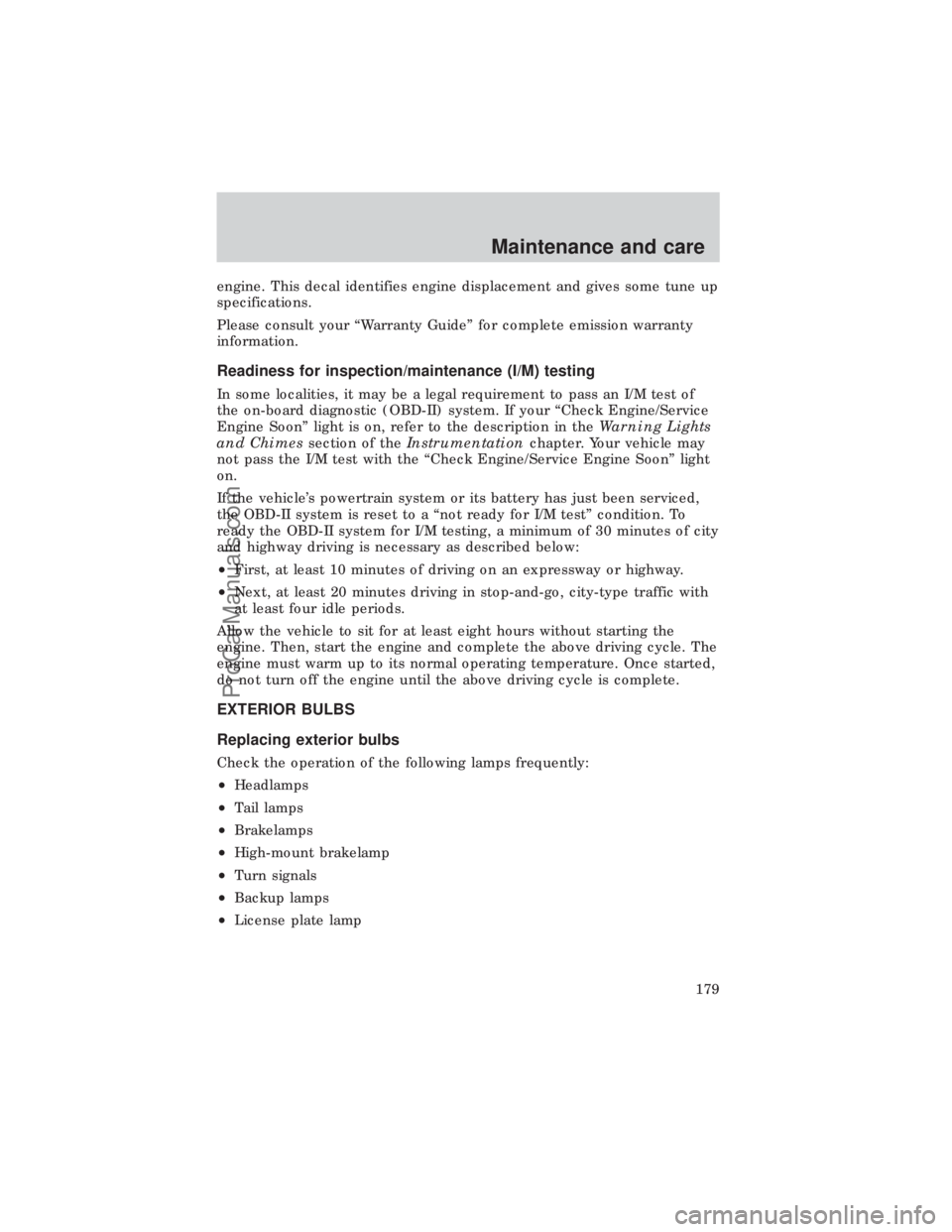
engine. This decal identifies engine displacement and gives some tune up
specifications.
Please consult your ªWarranty Guideº for complete emission warranty
information.
Readiness for inspection/maintenance (I/M) testing
In some localities, it may be a legal requirement to pass an I/M test of
the on-board diagnostic (OBD-II) system. If your ªCheck Engine/Service
Engine Soonº light is on, refer to the description in theWarning Lights
and Chimessection of theInstrumentationchapter. Your vehicle may
not pass the I/M test with the ªCheck Engine/Service Engine Soonº light
on.
If the vehicle's powertrain system or its battery has just been serviced,
the OBD-II system is reset to a ªnot ready for I/M testº condition. To
ready the OBD-II system for I/M testing, a minimum of 30 minutes of city
and highway driving is necessary as described below:
²First, at least 10 minutes of driving on an expressway or highway.
²Next, at least 20 minutes driving in stop-and-go, city-type traffic with
at least four idle periods.
Allow the vehicle to sit for at least eight hours without starting the
engine. Then, start the engine and complete the above driving cycle. The
engine must warm up to its normal operating temperature. Once started,
do not turn off the engine until the above driving cycle is complete.
EXTERIOR BULBS
Replacing exterior bulbs
Check the operation of the following lamps frequently:
²Headlamps
²Tail lamps
²Brakelamps
²High-mount brakelamp
²Turn signals
²Backup lamps
²License plate lamp
Maintenance and care
179
ProCarManuals.com
Page 183 of 208

Using the right bulbs
Function Number of
bulbsTrade number
Headlamps (low series) 2 H5054
Headlamps (high series) 2 9007
Park lamp and turn signal (front) 2 3157 NAK
Back-up lamps 2 3156K
License plate lamps 1 168
Stop/tail/side marker lamp 2 3357 K
Turn lamp (rear) 2 3156K
High-mount brakelamp 2 912
Cargo lamp 1 211-2
Dome lamp (standard) 1 912
Map/reading lamp 2 211-2
To replace all instrument panel lights - see your dealer
AIMING THE HEADLAMPS
The alignment of your headlamps should be checked by a qualified
service technician if:
²Oncoming motorists frequently signal you to deactivate your high
beams, and your high beams are not activated.
²The headlamps do not seem to provide enough light for clear night
vision.
²The headlamp beams are pointed substantially away from a slightly
down and to the right position.
CLEANING AND CARING FOR YOUR VEHICLE
Refer to the ªCustomer Assistance Guideº for a list of Ford-approved
cleaners, polishes and waxes.
Maintenance and care
183
ProCarManuals.com
Page 184 of 208
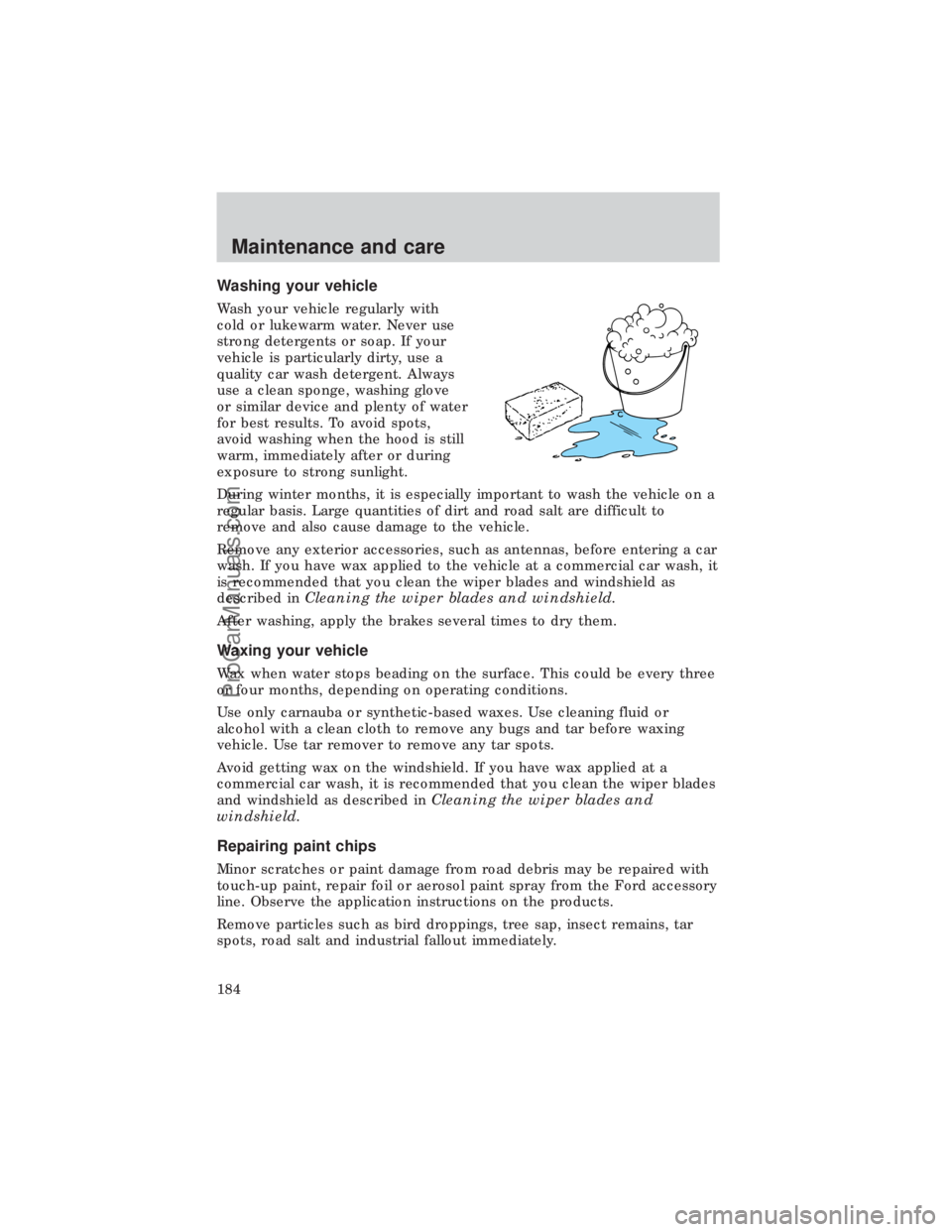
Washing your vehicle
Wash your vehicle regularly with
cold or lukewarm water. Never use
strong detergents or soap. If your
vehicle is particularly dirty, use a
quality car wash detergent. Always
use a clean sponge, washing glove
or similar device and plenty of water
for best results. To avoid spots,
avoid washing when the hood is still
warm, immediately after or during
exposure to strong sunlight.
During winter months, it is especially important to wash the vehicle on a
regular basis. Large quantities of dirt and road salt are difficult to
remove and also cause damage to the vehicle.
Remove any exterior accessories, such as antennas, before entering a car
wash. If you have wax applied to the vehicle at a commercial car wash, it
is recommended that you clean the wiper blades and windshield as
described inCleaning the wiper blades and windshield.
After washing, apply the brakes several times to dry them.
Waxing your vehicle
Wax when water stops beading on the surface. This could be every three
or four months, depending on operating conditions.
Use only carnauba or synthetic-based waxes. Use cleaning fluid or
alcohol with a clean cloth to remove any bugs and tar before waxing
vehicle. Use tar remover to remove any tar spots.
Avoid getting wax on the windshield. If you have wax applied at a
commercial car wash, it is recommended that you clean the wiper blades
and windshield as described inCleaning the wiper blades and
windshield.
Repairing paint chips
Minor scratches or paint damage from road debris may be repaired with
touch-up paint, repair foil or aerosol paint spray from the Ford accessory
line. Observe the application instructions on the products.
Remove particles such as bird droppings, tree sap, insect remains, tar
spots, road salt and industrial fallout immediately.
Maintenance and care
184
ProCarManuals.com
Page 200 of 208
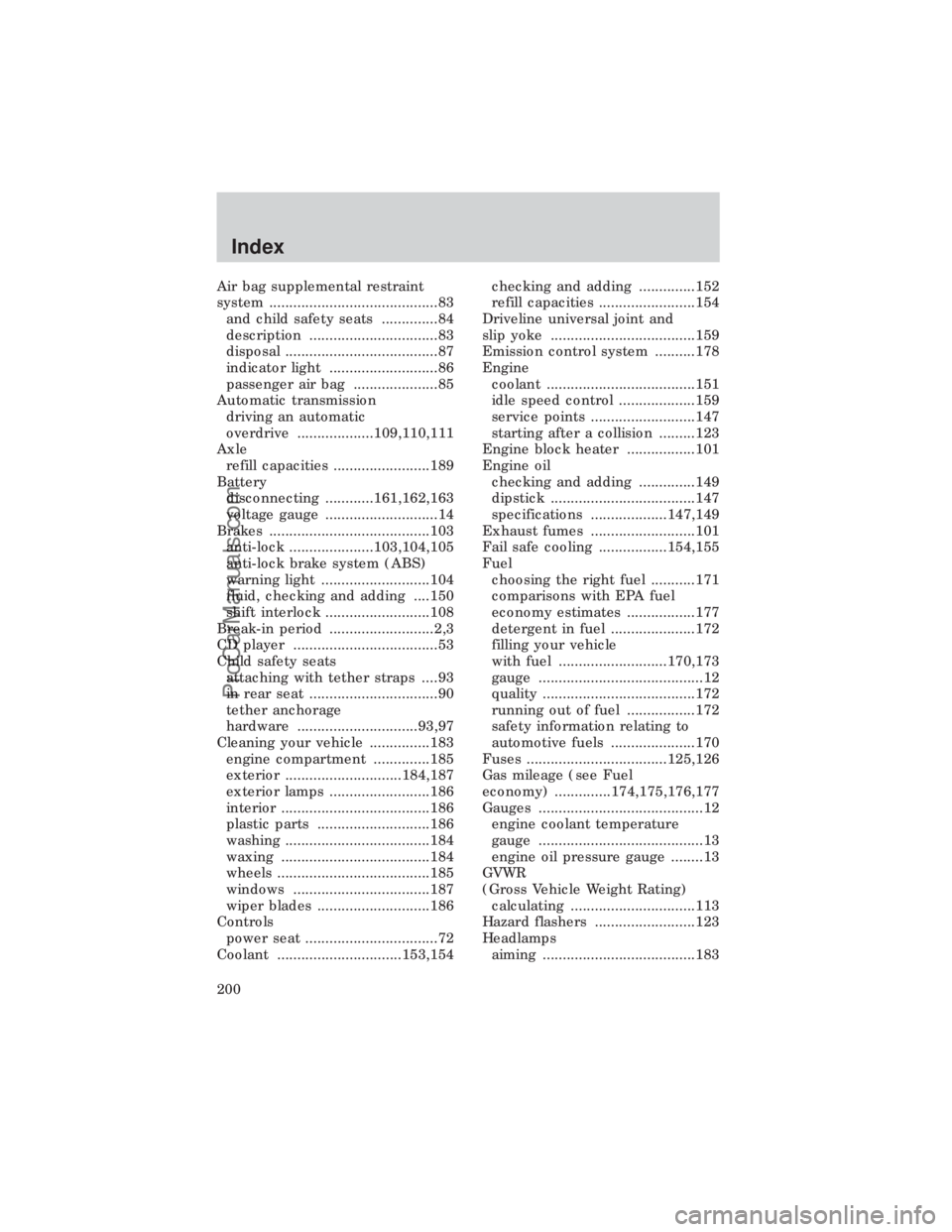
Air bag supplemental restraint
system ..........................................83
and child safety seats ..............84
description ................................83
disposal ......................................87
indicator light ...........................86
passenger air bag .....................85
Automatic transmission
driving an automatic
overdrive ...................109,110,111
Axle
refill capacities ........................189
Battery
disconnecting ............161,162,163
voltage gauge ............................14
Brakes ........................................103
anti-lock .....................103,104,105
anti-lock brake system (ABS)
warning light ...........................104
fluid, checking and adding ....150
shift interlock ..........................108
Break-in period ..........................2,3
CD player ....................................53
Child safety seats
attaching with tether straps ....93
in rear seat ................................90
tether anchorage
hardware ..............................93,97
Cleaning your vehicle ...............183
engine compartment ..............185
exterior .............................184,187
exterior lamps .........................186
interior .....................................186
plastic parts ............................186
washing ....................................184
waxing .....................................184
wheels ......................................185
windows ..................................187
wiper blades ............................186
Controls
power seat .................................72
Coolant ...............................153,154checking and adding ..............152
refill capacities ........................154
Driveline universal joint and
slip yoke ....................................159
Emission control system ..........178
Engine
coolant .....................................151
idle speed control ...................159
service points ..........................147
starting after a collision .........123
Engine block heater .................101
Engine oil
checking and adding ..............149
dipstick ....................................147
specifications ...................147,149
Exhaust fumes ..........................101
Fail safe cooling .................154,155
Fuel
choosing the right fuel ...........171
comparisons with EPA fuel
economy estimates .................177
detergent in fuel .....................172
filling your vehicle
with fuel ...........................170,173
gauge .........................................12
quality ......................................172
running out of fuel .................172
safety information relating to
automotive fuels .....................170
Fuses ...................................125,126
Gas mileage (see Fuel
economy) ..............174,175,176,177
Gauges .........................................12
engine coolant temperature
gauge .........................................13
engine oil pressure gauge ........13
GVWR
(Gross Vehicle Weight Rating)
calculating ...............................113
Hazard flashers .........................123
Headlamps
aiming ......................................183
Index
200
ProCarManuals.com
Page 201 of 208

bulb specifications ..................183
high beam ............................11,15
warning chime ..........................11
Heating ........................................16
auxiliary heater and air
conditioner ...........................21,22
heater only system .........16,17,18
heating and air conditioning
system .............................18,19,20
Hood ..........................................146
Ignition .......................................195
Inspection/maintenance
(I/M) testing ..............................179
Instrument panel
cleaning ...................................186
Keys
key in ignition chime ...............11
positions of the ignition ...........56
Lamps
daytime running light ...............15
headlamps .................................15
headlamps, flash to pass ..........16
instrument panel, dimming .....16
interior lamps ...........................63
replacing bulbs ..179,180,181,182
Lane change indicator
(see Turn signal) ........................57
Lights, warning and indicator
air bag ........................................10
anti-lock brakes (ABS) ..............8
brake ............................................8
charging system ........................10
engine oil pressure ...................11
safety belt .................................10
service engine soon .................8,9
turn signal indicator .................10
Lumbar support,
seats ..............................73,74,75,76
Mirrors
side view mirrors (power) .......65
Motorcraft parts ........................174
Octane rating ............................172Odometer .....................................14
Overdrive .....................................62
Panic alarm feature, remote
entry system ................................67
Parking brake ............................105
Power distribution box
(see Fuses) ...............................129
Power door locks ........................64
Power steering ..........................107
fluid, checking and adding ....156
Radio ...................23,24,25,26,27,28
29,30,31,32,33,34,35,36,37
Relays .................................125,131
Remote entry system .................65
illuminated entry ......................70
locking/unlocking doors ......65,66
replacement/additional
transmitters ...............................69
replacing the batteries .............67
Safety belts (see Safety
restraints) ....................................11
Safety restraints
cleaning the safety belts ...82,187
extension assembly ..................81
for children ..........................87,88
lap belt ......................................80
warning light and chime .....11,82
Seat belts (see Safety
restraints) ................76,77,78,79,80
Seats ............................................71
child safety seats ......................89
Servicing your vehicle ..............145
Spark plugs, specifications .......188
Special notice ................................3
ambulance conversions ..............3
diesel-powered vehicles .............4
Specification chart, lubricants .193
Speed control ..............................57
Speedometer ...............................12
Starting your vehicle ...........98,100
jump starting ............139,140,142
Index
201
ProCarManuals.com